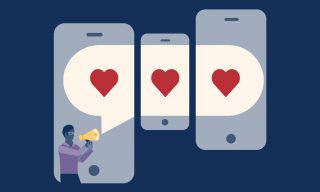Mark Zuckerberg announces the development of the Facebook ‘dislike’ button.
Since way-back-when, Facebook users have been crying out for a dislike button, something that solves the awkward, and very 21st century conundrum of ‘liking’ a sad or upsetting post. Yesterday, Mark Zuckerberg answered our #firstworldproblem prayers and announced that they’re currently in the development stages.
“Probably hundreds of people have asked about this, and today is a special day because today is the day that I actually get to say we are working on it [the dislike button], and are very close to shipping a test of it.” – Mark Zuckerberg, BBC News
This is a great leap for the world of social media and shows that Facebook are definitely listening to their now 1.5 billion users, but at the same time, it opens a lot of questions when it comes to how we use Facebook on both a personal and professional level.
Where’s the button going to be?
We imagine the dislike button will be available on posts, videos and photos, but where does it go beyond that? If a dislike button pops up in the comments and replies section, it could mean that the social dynamic of Facebook might change into a more forum-style. Another thing to consider is whether the dislike button will appear on Facebook ads and sponsored posts – what will this mean from both a brand and customer perspective? Even something as simple as where the button is placed will have a profound effect on how people interact with content and how they get their point across to brands and other users of the channel.
How do we use the dislike button?
According to Mark Zuckerberg, the dislike button is intended to show empathy, when clicking ‘like’ on sad posts feels insensitive, but a lot of people have noted that it also opens doors to negativity. Additionally, there is confusion on what clicking the ‘dislike’ button actually means.
@MadeBrave open to misunderstanding without context. Does mean “I don’t like this post”,or “I agree with the -ve sentiments in post too”?
— Julie Twaddell (@the_macjules) September 16, 2015
When Twitter introduced their favourite button, it was intended as a tool for bookmarking content to read later. As time progressed, people started using it in the same way that the Facebook ‘like’ button is used, in addition to its original purpose. Mark Zuckerberg is very clear on what the ‘dislike’ button is intended for, but unless there’s a way to control the mechanic, Facebook users alone will determine the outcome.
How will it affect brands?
From the perspective of a brand, the dislike button would introduce a plethora of new variables to consider across the entire board of social media marketing. When it comes to customer service, brands would be under more pressure to not only respond (as they should already), but to respond with exactly what customers want to hear, which might not always be possible.
Additionally, the introduction of the dislike button could greatly impact content – Facebook users might be more likely to ‘dislike’ than to write a negative comment, so brands may need to think even more carefully when it comes to posting content, or alternatively, brands might be more inclined to post more controversial content to increase interaction. On another note, if the dislike button is applied to Facebook advertising, it could change the way we monitor the success of ads. Already, Facebook users have the option of choosing whether or not they want to see certain ads in their feed, but a dislike button would perhaps be a quicker way of determining this.
Additionally, depending on whether an advert has a significant amount of dislikes, it poses the question as to whether this will be taken into consideration of the Facebook algorithm and have an effect on the reach of sponsored ads. Again, this all depends on where the dislike button is placed and whether it will be applied to brand pages at all.
What do you think?
We asked our followers on Twitter about their thoughts on the Facebook dislike button, and here’s what they had to say. Join the conversation on the MadeBrave® Twitter.
Thumbs down for me @MadeBrave, can see the reasoning that it’s to express empathy but could also be used as form of bullying
— Lisa Breslin (@lisa_bres) September 16, 2015
From brand perspective, a way to feed the trolls but also a good way of measuring sentiment so good & bad aspects @MadeBrave — Lisa Breslin (@lisa_bres) September 16, 2015
@MadeBrave Not sure. It’s a hard one cause my Facebook is friends and family, I have enough of a relationship to just comment my opinion!
— Kym Primrose (@x_MissKymmy_x) September 16, 2015
@MadeBrave Any app should encourage positive interaction. A dislike button only brings unnecessary negativity. So a thumbs down from us. — Celtic Fighter (@itisinourblood) September 16, 2015
@MadeBrave In many cases, certainly. However it’s use will be misinterpreted more often than not. The misuse would be our main concern.
— Celtic Fighter (@itisinourblood) September 16, 2015
@MadeBrave I feel there is much more need for a ‘couldn’t give a toss’ button. — Firebrat (@firebrat) September 16, 2015
Update: Rather than developing a dislike button, Facebook launched reactions – including ‘Wow’, ‘Sad’ and ‘Love’. This way, users don’t have to ‘Like’ upsetting posts and it takes away some of the nasty stuff that comes with a dislike button, so it’s a thumbs up all round from us! But what do you guys think?
What are your thoughts on Facebook reactions?
— MadeBrave® (@MadeBrave) February 24, 2016




